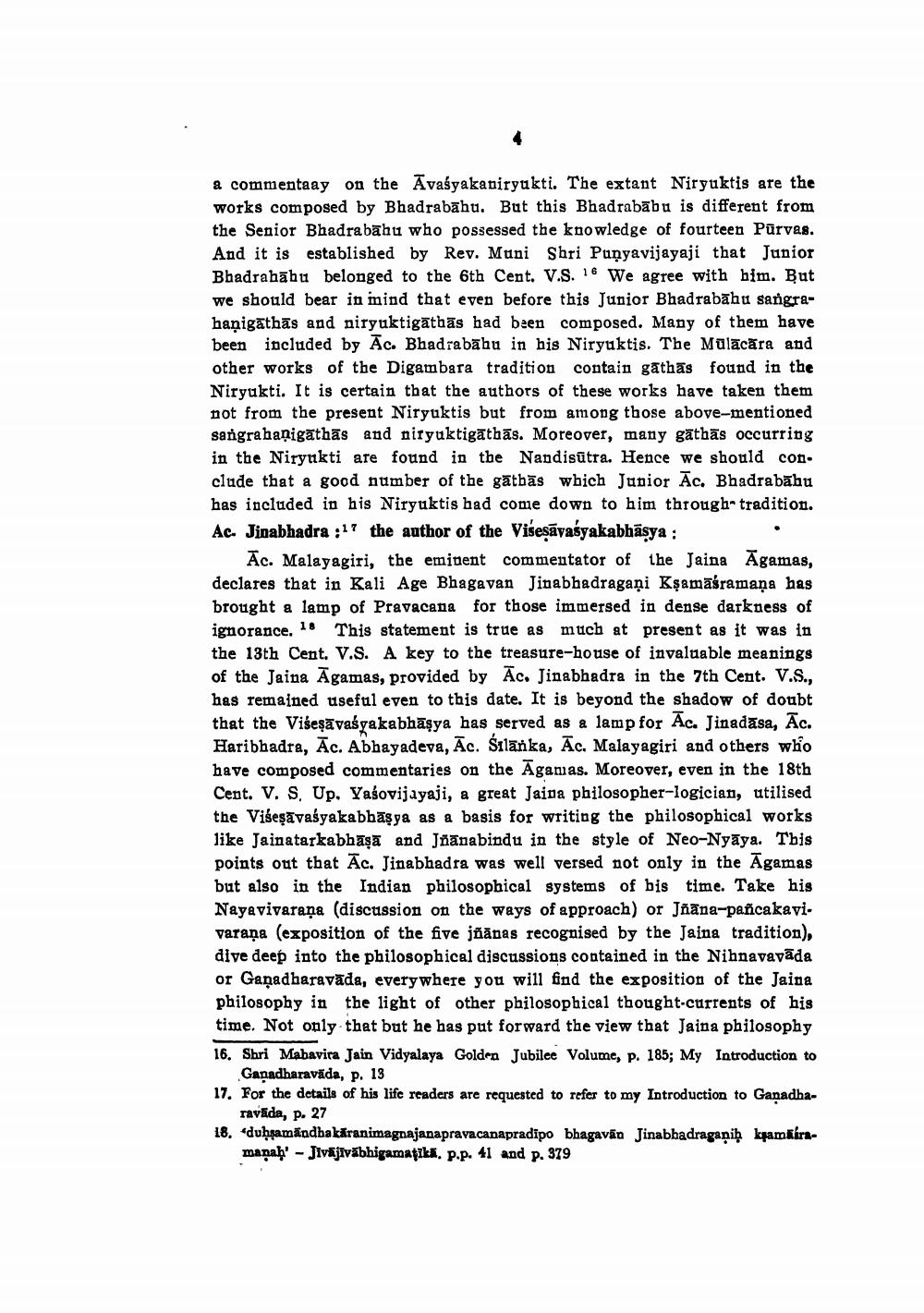________________
a commentaay on the Avaśyakaniryukti. The extant Niryuktis are the works composed by Bhadrabāhu. But this Bhadrababu is different from the Senior Bhadrabahu who possessed the knowledge of fourteen Pūrvas. And it is established by Rev. Muni Shri Punyavijayaji that Junior Bhadrahābu belonged to the 6th Cent. V.S. 16 We agree with him. But we should bear in mind that even before this Junior Bhadrabāhu sangrahaņigāthās and niryuktigāthas had been composed. Many of them have been included by Ac. Bhadrabāhu in his Niryuktis. The Mulācāra and other works of the Digambara tradition contain gāthas found in the Niryukti. It is certain that the authors of these works have taken them not from the present Niryuktis but from among those above-mentioned sangrahaņigāthās and niryuktigāthās. Moreover, many gathās occurring in the Niryukti are found in the Nandisūtra. Hence we should con. clude that a good number of the gātbās which Junior Ac. Bhadrabāhu has included in his Niryuktis had come down to him through- tradition. Ac. Jinabhadra :17 the author of the Višeşāvaśyakabhāsya :
Ac. Malayagiri, the eminent commentator of the Jaina Āgamas, declares that in Kali Age Bhagavan Jinabhadragaại Kşamasramaņa has brought a lamp of Pravacana for those immersed in dense darkness of ignorance. 18 This statement is true as much at present as it was in the 13th Cent. V.S. A key to the treasure-house of invaluable meanings of the Jaina Āgamas, provided by Ac. Jinabhadra in the 7th Cent. V.S., has remained useful even to this date. It is beyond the shadow of doubt that the Viseşāvaśyakabhāşya has served as a lamp for Ac. Jinadasa, Ac. Haribhadra, Ac. Abhayadeva, Āc. Śılānka, Āc. Malayagiri and others who have composed commentaries on the Āganias. Moreover, even in the 18th Cent. V. S. Up. Yasovijayaji, a great Jaipa philosopher-logician, utilised the Višeşāvaśyakabbāşya as a basis for writing the philosophical works like Jainatarkabhāşa and Jñānabindu in the style of Neo-Nyāya. This points out that Ac. Jinabhadra was well versed not only in the Agamas but also in the Indian philosophical systems of bis time. Take his Nayavivarana (discussion on the ways of approach) or Jñāna-pañcakavi. varaņa (exposition of the five jñānas recognised by the Jaina tradition), dive deep into the philosophical discussions contained in the Nihnavavāda or Gañadharavāda, everywhere you will find the exposition of the Jaina philosophy in the light of other philosophical thought-currents of his time. Not only that but he has put forward the view that Jaina philosophy 16. Shri Mahavira Jain Vidyalaya Golden Jubilee Volume, p. 185; My Introduction to
Ganadharavāda, p. 13 17. For the details of his life readers are requested to refer to my Introduction to Ganadha
ravāda, p. 27 18. 'duhşamāndhakaranimagnajanapravacanapradipo bhagavān Jinabhadraganiḥ kyamkira
manah' - Jivijivábhigamatiki. p.p. 41 and p. 379




